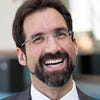One Data, Undivided
Having multiple copies of data to satisfy users and security concerns is costing companies time and money to maintain. The solution is the cloud.

is straining well beyond its technical capabilities to deliver access to smartphones, tablets, and an increasingly mobile workforce. Meanwhile the file sync-and-share players, such as Dropbox and Box, have moved in to capitalize on this need for data mobility.
Recently, an IT director from one of the largest engineering firms in the world told me that they were considering adopting Box for their mobile users. They were being kept from moving forward by concerns about security and how to keep data synchronized with Box. Their engineering users couldn't sacrifice high-performance access to the data, which today sits on the firm's powerful file servers. The challenge for them was how to extend mobile access to data without introducing yet another storage platform and adding another unmanaged copy.
Every organization needs to be able to point to an authoritative copy of data. Access control, versioning, audit trails -- everything -- converges on that single logical instance of data. A forward-looking CIO said it best in a recent email exchange, "We want one central, secure, authoritative copy of each data asset… and many ways to access and present the data (again in a secure manner) to our internal and external teams." He manages the global footprint of a firm with dozens of locations, all needing high-performance, mobile, and selected access of the same data to outside partner organizations.
Just as virtualization first separated the operating system from the hardware -- enabling virtualization to deliver its killer use-case, server consolidation -- the road to data consolidation also begins by separating the data from the hardware. Several firms are trying to deliver on this notion of one central version of the data. EMC has introduced ViPR, which abstracts the data services away from the actual storage gear in use. Up-and-coming companies such as Actifio tout a cure to copy-data creep in order to help large organizations streamline backup and disaster recovery.
My own company, Nasuni, has evolved the storage controller design in order to use public cloud storage. Because the cloud already makes copies, it can eliminate the need for IT to make additional backup or disaster recovery copies, while at the same time it enables global access.
Our common vision for the industry is to give IT organizations control over a single, fully protected, fully versioned instance of every data asset. When high-performance access is needed, the data is instantiated in a high-performance system. When access is needed across multiple locations, the copies of the data appear in all those locations and a global lock prevents conflicts in order to maintain one clean version of the data. Enabling mobile access means just that: stretching the perimeter of access to include mobile devices rather than copying the data to yet another storage platform.
Data consolidation establishes complete control over each data asset and, once and for all, liberates IT from having to make, track, and manage all the copies.
Solid state alone can't solve your volume and performance problem. Think scale-out, virtualization, and cloud. Find out more about the 2014 State of Enterprise Storage Survey results in the new issue of InformationWeek Tech Digest.
Read more about:
2014About the Author(s)
You May Also Like
How to Amplify DevOps with DevSecOps
May 22, 2024Generative AI: Use Cases and Risks in 2024
May 29, 2024Smart Service Management
June 4, 2024







